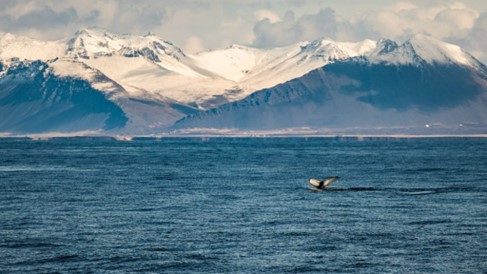Winter is such a magical time of year to come visit Iceland! Despite the short daylight hours, there is still so much that you can do. Seeing the otherworldly landscape around the country powdered with snow is breathtaking, and if you’re lucky you might even catch the Northern Lights, an amazing natural phenomenon that deserves to be on everyone’s bucket list. We also offer whale watching tours year-round, even in the middle of winter!
People are often surprised to hear that we go whale watching in the winter. After all, the summer months (April – September) are our “high season” due to the long daylight hours. But actually, it is possible to see cetaceans (whales, dolphins, and porpoises) on any given day of the year. In this blog post, I wanted to share some information and advice for those wishing to go whale watching in the wintertime from Reykjavík. Just note that most of the information in this blog post applies to whale watching tours that sail from October until April.
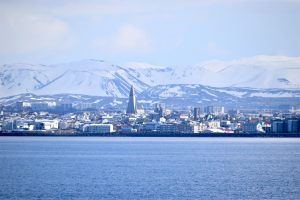
Photo: Reykjavík in winter
For our whale watching tours, we set sail from the Old Harbor in Reykjavík, out into the feeding grounds of Faxaflói, the largest bay in Iceland. Our Whale Watching Classic tour is 3-3.5 hours long, giving us plenty of time to enjoy the sailing and admire the beautiful landscape, all while searching for our whale friends. But not all whale watching tours are created equal, and they can vary depending on the season.
For example, some of the animals that we see on our tours are seasonal. Minke whales spend their summer months here feeding and bulking up before heading southwards to breed and give birth. Their winter whereabouts are currently unknown, but one study suggests they may head down to the Canary Islands in the winter. Minke whales are the most commonly sighted species on our whale watching tours in summer, but they are very rare during the winter.
However, humpback whales may visit Faxaflói at any point in the year – and indeed, during the winter, humpbacks are the most common species of large whales that we spot on our tours. The migration of humpback whales in the North Atlantic Ocean is poorly understood. Indeed, many humpback whales do not leave Iceland at all during the winter, instead choosing to stay and feed in the rich, nutrient-rich waters around the country.
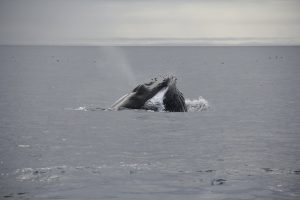
Photo: Feeding humpback whale in Faxaflói Bay
But whales come in all sizes! The toothed whales that we see on our tours, the white-beaked dolphins and the harbor porpoises, do not migrate, and so stay around Iceland all year round. We tend to see many of them throughout the year, and these toothed whales are the two most commonly sighted species during the winter months.
The bird life changes as well during the winter months. The most common bird species are northern gannets, beautiful large seabirds which can plummet into the sea from high in the air to hunt for prey, northern fulmars, a close relative of the albatross which can live for 50 years or more, and great black-backed gulls, the largest gull species on Earth. We also spot other species such as common guillemots, Iceland gulls, Manx shearwaters, and more. You won’t find any Atlantic puffins or arctic terns here in the winter, as they only visit Iceland during the summer to nest and lay eggs.
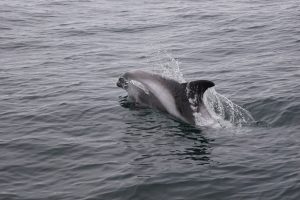
Photo: White-beaked dolphin (see more info in our blog about how to identify a White-beaked dolphin)
Things to Know Before you Go
Iceland is located close to the North Atlantic Current, which brings warmer water to our shores. This means that temperatures here are surprisingly “warm” considering our subarctic location. But out at sea, things can get very cold, very fast! We always provide free thermal overalls to our passengers to help keep them cozy during our adventures, but you still need to bring warm clothing to wear underneath. Think layers – a thermal base layer, a thicker mid-layer (an Icelandic wool sweater is perfect for this), and something windproof on top to really trap the heat. Wool socks and sturdy hiking shoes or boots will keep your feet toasty, and also stable, as things can get icy around Reykjavík and the Old Harbor. And don’t forget a hat, gloves, and a scarf.
Weather in Iceland can be unpredictable, regardless of the time of year. But during the winter, it tends to get much windier. At times this can result in rougher seas, so if that happens, then get ready for an exciting adventure! It can happen sometimes that the sea conditions are too rough to sail from Reykjavik, and they are better elsewhere. In cases like those, we will sail from a different harbor, and provide our passengers with free round-trip transportation from our ticket office to the harbor. Just keep in mind that other harbor may be up to a one hour drive away, and so this could extend the total tour time by up to 2 hours. In cases of unfavorable sea conditions, we always cancel our tours if conditions become unsafe.
During the winter, the daylight hours are very short – only about 4 hours in the middle of winter. As a result, we only offer one whale watching tour per day, departing at 13:00. So, plan your schedule accordingly. However, there is something dreamy about seeing the sun hang low in the sky, illuminating the snowy mountains while we search for whales. You can often get some beautiful photos of the area like this!
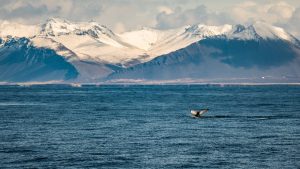
Photo: Federico Facchin
The last thing to keep in mind is that we are at the mercy of nature and wildlife on our Whale Watching tours. We cannot control the amazing animals we search for, nor would we ever want to. Most of the time, they do decide to appear for us, and we get some very nice sightings as a result. But it can happen sometimes, and a bit more often in the winter, that as the animals move around in and out of the feeding grounds, they decide not to show themselves off. If this does happen, we offer our passengers a free ticket to try again, which never expires. But think of it like this – that’s like getting two boat tours for the price of one!
And if you’re looking for a fun and educational add-on to your whale watching tour, then I highly recommend visiting the Whales of Iceland museum at some point during your stay. There’s nothing like it anywhere else in the world, and you can walk amongst these gentle giants and explore life-sized models of 23 different cetacean species. Special Tours passengers can purchase museum tickets separately for a fraction of the usual cost, or you can book a combo tour that provides you with a whale watching ticket, and museum admission, for the same price. I think it’s the coolest museum in Iceland – but then again, I’m a bit biased!
Regardless of the time of year you decide to go whale watching in Reykjavík, by choosing Special Tours you will be guaranteed an adventure led by an experienced crew, and a friendly and knowledgeable guide, aboard one our comfortable sightseeing boats. We have been offering boat tours here for more than 2 decades, and we are always happy to pass along our experience to you!
Blog by Jonathan Rempel
Instagram: @jon.rempel
Special Tours Head Guide
Please note that this blog applies to whale watching tours from Reykjavík from October until early April.
